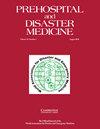Using Artificial Intelligence to Develop Educational Content for Teaching Children on Cardiopulmonary Resuscitation.
IF 2.1
4区 医学
Q2 EMERGENCY MEDICINE
Prehospital and Disaster Medicine
Pub Date : 2023-10-01
Epub Date: 2023-09-05
DOI:10.1017/S1049023X23006258
引用次数: 0
Abstract
Dear Editor, Children make up around 25% of the total world population and therefore constitute a colossal (two-billion)1 contingent of potential rescuers that could greatly enhance community response in out-of-hospital cardiac arrest (OHCA). Considering the high motivation of children to learn cardiopulmonary resuscitation (CPR) and their ability to transfer the life-saving competencies to other people, teaching all school children in resuscitation is currently strongly endorsed by international health organizations as one of the key public initiatives for improving bystander CPR rates and survival after OHCA.2,3 In 2015, it has been recommended to teach school children in resuscitation annually from the age of 12 years or less.2 A recent scientific statement by the International Liaison Committee on Resuscitation3 suggests that children should be taught basic theoretical concepts of OHCA response beginning from the preschool age (four years old and above). Apparently, world-wide implementation of CPR education for children of various ages necessitates tremendous organizational efforts. One of themajor tasks involves development of age-appropriate training curriculum and educational materials that should be adopted to cultural, social, and economic contexts of specific countries. This challenge is associated with expenditure of time and money, and therefore may constitute a barrier for wide-spread introduction of CPR education for children, especially in resource-limited settings.4 Today, artificial intelligence (AI) chatbots powered with Generative Pre-Trained Transformer (GPT) models garner great public and researcher attention. Being trained on a large dataset of text in multiple languages, these models can produce highly sophisticated human-like responses based on a context of input text.5 Free GPT chatbots, including ChatGPT (OpenAI; San Fransico, California USA) and the new Bing (Microsoft Corporation; Redmond, Washington USA), became extremely popular due to their impressive capabilities for solving a range of language-based tasks, including question answering, machine translation, and text generation.5 From the resuscitation education perspective, it seems important and timely to explore the potential of using the AI-chatbots for developing educational materials on CPR. In May 2023, the new Bing chatbot was queried: “Propose 10 types of educational materials to teach children on CPR that Bing chatbot can create.” The chatbot responded with a list of educational materials ranging from a song explaining the steps of CPR to a programming code generating random CPR scenarios and challenges to solve (Table 1). When asked to create certain materials, it showed an impressive ability to comprehend a query and generate age-appropriate textual content summarizing key points of resuscitation. This suggests rather promising opportunities to use the chatbot for composing valuable educational resources, along with anticipated time and cost savings that could expedite implementation of CPR education for children. However, it is important to bear in mind that the GPT-based chatbots are a kind of “black box technology” that can give plausible-sounding but incorrect responses.5 Therefore, the AI-generated content should always be meticulously reviewed and verified by a human expert before its intended use. Further research is required to determine the best practices for using the cutting-edge GPT-powered chatbots in a safe and responsible way with the aim of promoting resuscitation education across the world. Department of General Surgery, Anesthesiology, Resuscitation and Emergency Medicine, Medical Academy named after S.I. Georgievsky of V.I. Vernadsky Crimean Federal University, Simferopol, Russian Federation利用人工智能开发儿童心肺复苏教育内容。
本文章由计算机程序翻译,如有差异,请以英文原文为准。
求助全文
约1分钟内获得全文
求助全文
来源期刊

Prehospital and Disaster Medicine
Medicine-Emergency Medicine
CiteScore
3.10
自引率
13.60%
发文量
279
期刊介绍:
Prehospital and Disaster Medicine (PDM) is an official publication of the World Association for Disaster and Emergency Medicine. Currently in its 25th volume, Prehospital and Disaster Medicine is one of the leading scientific journals focusing on prehospital and disaster health. It is the only peer-reviewed international journal in its field, published bi-monthly, providing a readable, usable worldwide source of research and analysis. PDM is currently distributed in more than 55 countries. Its readership includes physicians, professors, EMTs and paramedics, nurses, emergency managers, disaster planners, hospital administrators, sociologists, and psychologists.
 求助内容:
求助内容: 应助结果提醒方式:
应助结果提醒方式:


